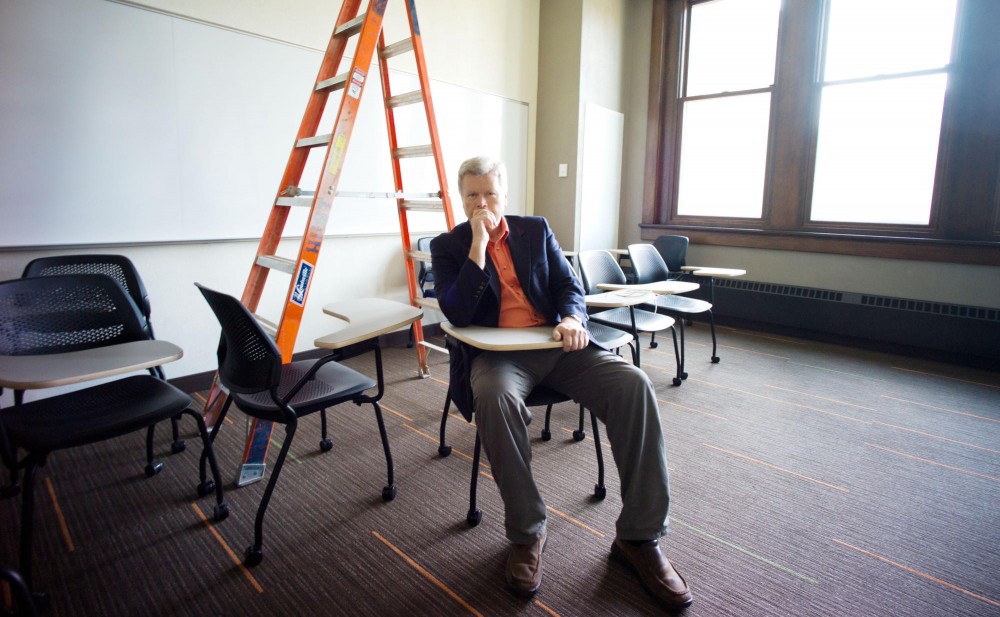Construction projects at the University of Minnesota are hard to miss âÄî theyâÄôre loud and theyâÄôre all over campus. Mike Perkins, the boss of all things construction, tends to do his work a bit more quietly.
In the course of a day, Perkins works with project managers for dozens of buildings being renovated or constructed on campus. With his team of 23 employees on the fourth floor Capital Planning and Project Management office in the Donhowe Building, he chooses contractors out of the companies vying to provide construction services.
As the associate vice president for CPPM, Perkins often has to explain big and small project details alike to University department heads, the Board of Regents and the administration. ItâÄôs his responsibility to be the keeper of the long-range vision for the aesthetic of the University.
âÄúYou look at the entire physical perspective of campus and look at how you want to plan it and manifest it physically,âÄù Perkins said.
Since his arrival in June 2003, Perkins has made intentional changes to his department âÄî and accepted the changes hoisted on him by the recession. Now, heâÄôs preparing for his retirement from the University in January.
For the five years prior to PerkinsâÄô arrival at the University, only one-third of all projects were completed on time and on budget, said Kathleen OâÄôBrien, his boss and vice president of University Services. Since 2003, 90 percent of projects have been completed on time and 95 percent were completed at or under budget.
âÄúMike has been the person in charge of making this happen,âÄù OâÄôBrien said.
Another quantifiable achievement, she said, is that in 2002 alone, disputes with contractors led to more than $15 million in claims against the University. In the nearly nine years since PerkinsâÄô arrival, two contractors have made claims amounting to less than $500,000.
Paul Oelze, a CPPM employee for 13 years and the project manager who has led the renovation of Folwell Hall, said one unpleasant change was the centralization of CPPM.
Before, CPPM was part of Facilities Management, so project managers were distributed into FM districts rather than in the central office theyâÄôre in now.
âÄúI almost feel it was a bad thing âÄî I thought it worked well before. We knew the clients,âÄù Oelze said. The âÄúclientsâÄù are the departments within the University that sponsor construction projects.
Perkins acknowledged that some of the initial changes he made were unpopular.
âÄúA lot of people didnâÄôt like it âÄî because it was change. Because it affected them,âÄù he said.
Then, in 2008, recession slammed the architectural community, cutting jobs in that sector by almost half and impacting many University contractors, OâÄôBrien said.
As previously-funded projects were completed, the full impact of the economic haze began to reach CPPM, OâÄôBrien said. It wasnâÄôt until 2010 that its volume of business started to decrease and PerkinsâÄô staff was reduced by 40 percent, or by 17 positions.
âÄúThe work doesnâÄôt go away, though.âÄù Perkins said. âÄúWeâÄôve got half the projects but weâÄôve got half the people.âÄù
Perkins, who works at least 50 hours a week, said heâÄôs taken over the responsibilities of three directors that helped oversee project managers until they were let go last year.
âÄúWhen I go home, the briefcase is full,âÄù he said. âÄúI do a lot of reading. I canâÄôt do it here âĦ I have a home office.âÄù
Fortunately for him, PerkinsâÄô days in the office are coming to a close. The University is already searching for his replacement when he steps down in January.
Retirement wonâÄôt mean the usual laid-back lifestyle, though. While others would opt for the lake house, the 65-year-old former University swimmer plans to trek through Afghanistan and return to favorite locations in Central Asia.
Perkins has already accepted an invitation to stay with a local Afghan family that he befriended on a previous trip.
Perkins has been to base camps on three sides of Mount Everest and said his future to-do list includes driving the length of the Himalayas and fitting in plenty of white-water rafting.
âÄúNow I can travel as much as I want and stay as long as I want,âÄù Perkins said.


